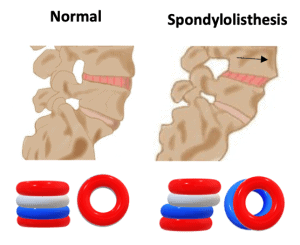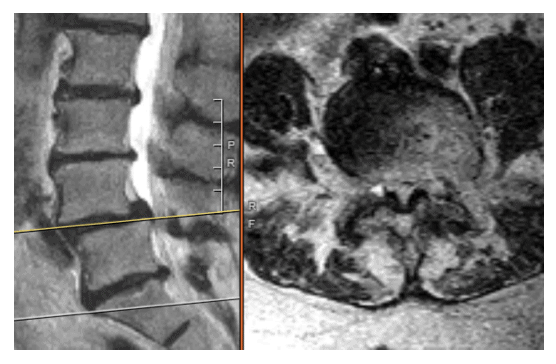What Is Spondylolisthesis?
Spondylolisthesis is a condition in which one vertebra in the spine slips forward over the vertebra below. The vertebra can sometimes slip behind the vertebra below which is not as common, this is referred to as retrolisthesis. This misalignment can narrow the space within the spinal canal, a condition known as spinal stenosis, which places pressure on the spinal cord and surrounding nerves. This can lead to pain, numbness, or weakness in the lower back and legs.
To help visualize this, imagine a stack of rings placed one on top of the other. If one ring slides forward out of alignment, the space in the center of the stack (where the nerves would be in your spine) becomes smaller. That narrowing is what can lead to pain and nerve-related symptoms.
What Are the Causes of Spondylolisthesis?
Spondylolisthesis can have a variety of causes. In some cases, it’s the result of trauma, such as a car accident, fall, or sports injury. In other cases, it develops gradually due to degenerative changes in the spine, such as arthritis or disc wear that occurs with aging. Less commonly, it may be related to a birth defect in the spine, repeated stress from certain sports or activities, or a condition called spondylolysis, which is a small fracture in a part of the vertebra.
What Are the Signs and Symptoms of Spondylolisthesis?
The symptoms of spondylolisthesis can vary depending on the severity of the slippage and whether nerves are affected. Common signs and symptoms include:



- Low back pain, especially during movement or prolonged standing
- Muscle spasms, particularly in the back or hamstrings
- Leg pain that may radiate downward (sciatica-like symptoms)
- Numbness, tingling, or weakness in the legs or feet
- Reduced flexibility or stiffness in the lower back
- Difficulty walking or standing for long periods
In more severe cases, spondylolisthesis may lead to noticeable changes in posture or walking ability.
What Are the Risk Factors for Spondylolisthesis?
Certain factors can increase the likelihood of developing spondylolisthesis, including:
- Aging, which leads to natural wear and tear in the spine
- Repetitive stress from sports or physically demanding work
- Genetics, particularly if a family member has a history of spinal conditions
- Previous spinal trauma or injury
- Spondylolysis, a stress fracture that can cause vertebral slippage
- Arthritis or degenerative disc disease
Athletes involved in gymnastics, football, or weightlifting may be at higher risk due to repeated hyperextension and strain on the lower spine.
How Is Spondylolisthesis Diagnosed?
Diagnosis begins with a detailed history and physical examination. Your provider will evaluate your symptoms, spinal alignment, flexibility, and nerve function. Imaging studies are typically needed to confirm the diagnosis and determine the degree of slippage. These may include:
- X-rays, which can clearly show vertebral misalignment
- MRI scans, which help assess nerve involvement and soft tissue structures
- CT scans, for detailed bone imaging
The severity of spondylolisthesis is graded from I to V, depending on how far the vertebra has slipped forward.
What Are the Treatment Options for Spondylolisthesis?
Not all cases of spondylolisthesis require surgery. Many patients improve with non-surgical care focused on reducing pain and improving spine stability. Conservative treatments may include:
Non-Surgical Treatments:
- Physical therapy to strengthen the core and support the spine
- Anti-inflammatory medications or muscle relaxants
- Epidural steroid injections to relieve nerve-related pain. This can also be used for diagnostic information to see if the area is causing you pain.
- Activity modification, such as avoiding movements that aggravate symptoms
- Bracing, especially in younger patients or those with mild slippage
If symptoms persist or worsen despite these treatments, surgery may be considered to stabilize the spine and relieve pressure on the nerves.
Why Does Spondylolisthesis Sometimes Require a Fusion?
In moderate to severe cases of spondylolisthesis, or when nerve compression is causing persistent leg pain or weakness, a spinal fusion may be recommended. A spinal fusion is a surgical procedure that permanently connects two or more vertebrae to prevent abnormal movement and correct spinal alignment.
By realigning the spine, the fusion relieves pressure on the facet joints—often a source of back pain—and decompresses the nerves, which reduces leg pain, numbness, or weakness. Without fusion, the unstable vertebra can continue to slip and cause ongoing symptoms or worsening deformity.
Are There Preventative Measures for Spondylolisthesis?
While not all cases can be prevented, there are steps you can take to protect your spine:
- Maintain a strong core through regular exercise
- Practice good posture, especially when lifting or sitting for long periods
- Avoid repetitive spinal stress or hyperextension movements
- Use proper technique during sports or heavy lifting
- Maintain a healthy weight to reduce stress on the spine
- Stay active, as regular movement helps keep the spine mobile and healthy
What Happens If Spondylolisthesis Is Left Untreated?
If spondylolisthesis is left untreated, the slippage can gradually worsen, increasing the risk of chronic pain, nerve damage, or permanent disability. As the vertebra continues to shift out of place, the spinal canal may narrow even further, compressing nerves and leading to muscle weakness, numbness, or difficulty walking. Early diagnosis and appropriate treatment can prevent these complications and help patients return to normal activity.
Are There Other Conditions Related to Spondylolisthesis?
Spondylolisthesis is often associated with or can lead to other spinal conditions, including:
- Spinal stenosis
- Degenerative disc disease
- Facet joint arthritis
- Spondylolysis (stress fracture in the vertebrae)
- Herniated discs
A full evaluation by a spine specialist is important to determine the presence of any related conditions and to tailor treatment accordingly.
Key Takeaways About Spondylolisthesis
- Spondylolisthesis is a spinal condition in which a vertebra slips forward over the one below it.
- It can result from trauma, aging, repetitive stress, or structural weakness.
- Common symptoms include back pain, leg pain, numbness, and stiffness.
- Many cases improve with non-surgical care such as physical therapy and medication.
- Spinal fusion may be necessary when symptoms are severe or persistent.
- Preventative care, proper body mechanics, and a healthy lifestyle can help reduce the risk of developing or worsening the condition.
Recommended Next Steps
If you’re experiencing persistent low back pain, leg symptoms, or difficulty with daily activities, it’s important to seek evaluation by a medical provider. Early diagnosis of spondylolisthesis can lead to better outcomes with conservative care and may help prevent progression. A spine specialist can guide you through your treatment options and help you regain mobility and quality of life.

